Shantungosaurus
Shantungosaurus, meaning "Shandong Lizard", is a genus of saurolophine hadrosaurid dinosaurs found in the Late Cretaceous Wangshi Group of the Shandong Peninsula in China, containing a single species, Shantungosaurus giganteus.[1] The stratigraphic interval of Shantungosaurus ranges from the top of the Xingezhuang Formation to the middle of the Hongtuya Formation, middle to late Campanian in age.[2] Shantungosaurus is so far the largest hadrosauroid taxon in the world: the greatest length of its femur is about 1.7 metres (5.6 ft), and the greatest length of its humerus is about 0.97 metres (3.2 ft).
| Shantungosaurus | |
|---|---|
.jpg) | |
| Restored skeletons | |
| Scientific classification | |
| Kingdom: | Animalia |
| Phylum: | Chordata |
| Clade: | Dinosauria |
| Order: | †Ornithischia |
| Suborder: | †Ornithopoda |
| Family: | †Hadrosauridae |
| Subfamily: | †Saurolophinae |
| Tribe: | †Edmontosaurini |
| Genus: | †Shantungosaurus Hu, 1973 |
| Species: | †S. giganteus |
| Binomial name | |
| †Shantungosaurus giganteus Hu, 1973 | |
| Synonyms | |
| |
Description
Shantungosaurus giganteus is one of the largest known ornithischians. The type skull is 1.63 metres (5.3 ft) long,[1] and the composite skeleton mounted at the Geological Institute of China in Beijing measures 14.7 metres (48 ft) in length.[3] Another mounted skeleton, originally referred to as Zhuchengosaurus maximus, measures 16.6 metres (54 ft) in length.[4] The largest individuals may have weighed as much as 16 tonnes (18 short tons).[5] Like all hadrosaurs its beak was toothless, but its jaws were packed with around 1,500 tiny chewing teeth. A large hole near its nostrils may have been covered by a loose flap of skin, which could be inflated to make sounds.
Discovery and species

First described in 1973,[6] Shantungosaurus is known from over five incomplete skeletons. Chinese scientist Xing Xu and his colleagues indicate that Shantungosaurus is very similar to and shares many unique characters with Edmontosaurus, forming an Asian node of an Edmontosaurus–Shantungosaurus clade, based on the new materials recovered in Shandong. Remains of several individuals, including skull bones, limb bones, and vertebrae, were found in Shandong, China. These specimens were classified in the new genus and species Zhuchengosaurus maximus in 2007.[4] However, further study showed that the supposedly distinct features of Zhuchengosaurus were simply a result of different growth stages.[7]

Recent maximum parsimony-based phylogenetic analyses of Hadrosauroidea from Xing and colleagues recovered a stable sister group relationship between Edmontosaurus and Shantungosaurus. Shantungosaurus is the single hadrosaurid from the Zhucheng area that is considered valid. Zhuchengosaurus and Huaxiaosaurus, both of which are known from the same region, have been interpreted by the analyses as junior synonyms of Shantungosaurus. All unequivocal morphological discrepancies among these three taxa could be attributed to intraspecific variation (ontogenetic and polymorphic variation) and post-depositional distortion.[2]
Classification
The following cladogram is the result of Prieto-Márquez et al. in 2016. It shows the position of Shantungosaurus as sister group of Edmontosaurus in the Edmontosaurini clade:[8]
| ||||||||||||||||||||||||||||||||||||||||||||||||||||||||||||||||||||||||||||||||||||||||||||||||||||||||||||||||||||||||||||||||||||||||||||||
See also
References
- Hu Chengzhi; Cheng Zhengwu; Pang Qiping; Fang Xiaosi (2001). Shantungosaurus giganteus (in Chinese). Beijing: Geological Publishing House. pp. 123–135 [English abstract]. ISBN 7-116-03472-2.
- Xing, Hai; Zhao, Xijin; Wang, Kebai; Li, Dunjing; Chen, Shuqing; Mallon, Jordan C; Zhang, Yanxia; Xu, Xing (2014). "Comparative osteology and phylogenetic relationship of Edmontosaurus and Shantungosaurus (Dinosauria: Hadrosauridae) from the Upper Cretaceous of North America and East Asia". Acta Geologica Sinica-English Edition. 88 (6): 1623–1652. doi:10.1111/1755-6724.12334.
- Glut, Donald F. (1997). "Shantungosaurus". Dinosaurs: The Encyclopedia. Jefferson, North Carolina: McFarland & Co. pp. 816–817. ISBN 0-89950-917-7.
- Zhao, X.; Li, D.; Han, G.; Hao, H.; Liu, F.; Li, L.; Fang, X. (2007). "Zhuchengosaurus maximus from Shandong Province". Acta Geoscientia Sinica. 28 (2): 111–122. doi:10.1007/s10114-005-0808-x.
- Horner, John R.; Weishampel, David B.; Forster, Catherine A (2004). "Hadrosauridae". In Weishampel, David B.; Dodson, Peter; Osmólska, Halszka (eds.). The Dinosauria (2nd ed.). Berkeley: University of California Press. pp. 438–463. ISBN 0-520-24209-2.
- C.-C. Hu. 1973. [A new hadrosaur from the Cretaceous of Chucheng, Shantung]. Acta Geologica Sinica 1973(2):179-206
- Ji, Y., Wang, X., Liu, Y., and Ji, Q. (2011). "Systematics, behavior and living environment of Shantungosaurus giganteus (Dinosauria: Hadrosauridae)." Acta Geologica Sinica (English Edition), 85(1): 58-65. doi:10.1111/j.1755-6724.2011.00378.x
- Prieto-Marquez, Albert; Erickson, Gregory M.; Ebersole, Jun A. (13 January 2016). "A primitive hadrosaurid from southeastern North America and the origin and early evolution of 'duck-billed' dinosaurs". Journal of Vertebrate Paleontology. 36 (2): e1054495. doi:10.1080/02724634.2015.1054495.
Sources
- Dong Zhiming (1992). Dinosaurian Faunas of China. Beijing: China Ocean Press. ISBN 3-540-52084-8.
- Mallam, John (2003). Encyclopedia of Dinosaurs. UK: Parragon Publishing. p. 157.

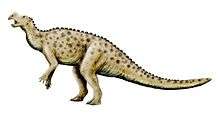

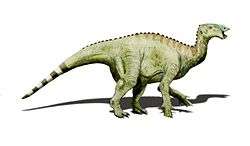
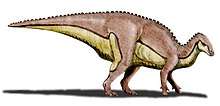
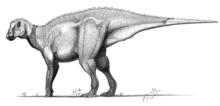
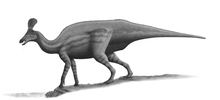
.jpg)